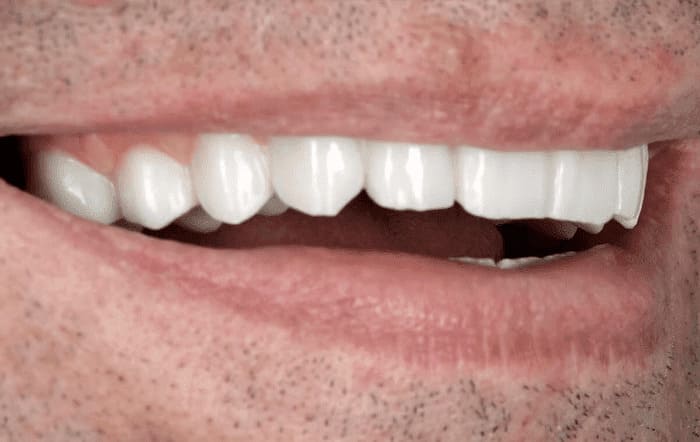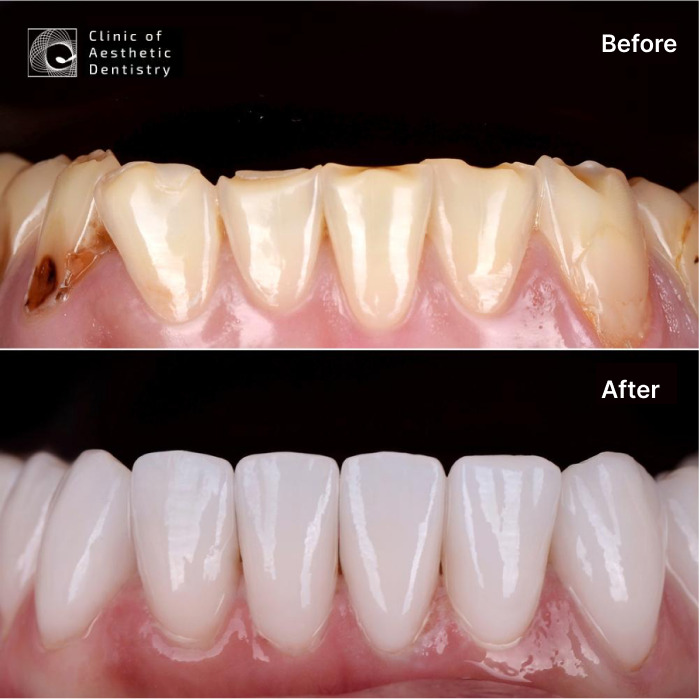How to Choose the Right Tooth Shape?

Contents:
The size, shape, and colour of teeth vary widely. New teeth (crowns, veneers, implants) should fit a particular person’s dentoalveolar system’s appearance and features. The dentist selects it individually; only in this case will the final result fully meet expectations and look harmonious.

How do you determine which teeth should be visible when talking?
When the doctor prescribes prosthetics (restoring the aesthetics and symmetry of the smile), the specialist chooses the size of the teeth, the shape of their cutting edge, the roundness of the corners, and the ratio of the width of incisors and canines. One of the most critical parameters is the length and shape of the dentures, which determines their visibility when talking, smiling, and laughing.
How Many Teeth Should Be Visible When Talking?
Typically, between 2 and 6 front teeth are visible when speaking. This depends on the jaw structure, lip volume, and mouth line. At the same time, the upper teeth are not fully visible, but only by 2-5 mm, and when the jaws are closed, they overlap the lower teeth by ⅓.
The easiest way to check the state of the smile is a phonetic test with the letter “M.” It is necessary to fix the lips in an ajar position, as when pronouncing this sound, and in this position to assess the visibility of the teeth.
Which Teeth Should Be Visible When Talking?
In everyday conversation with moderately active facial expression, the central and lateral incisors and canines on the upper and lower jaws are visible. If a person opens their mouth wide when singing or having an emotional conversation, the premolars, and even the molars may be visible.

Why Are My Lower Teeth Visible When Talking?
Most often, middle-aged and elderly patients face this problem. This is due to natural changes in muscle tone and redistribution of facial volume. After age 40, the tone of the circular muscles around the mouth weakens, and the tissue’s collagen and elastin content decreases. This causes the lip to droop slightly and cover the upper row of teeth while the lower row remains visible.
Other causes:
- mesial bite, in which the lower jaw is pushed forward;
- too thin lower lip;
- small size and underdevelopment of the upper jaw.
If the problem is related to age-related changes, it is aesthetic and can be corrected at the individual’s request. In this case, it will require the combined work of a dentist, cosmetologist, and/or plastic surgeon. If excessively visible lower teeth result from an incorrect bite, an orthodontist or an oral surgeon can help the patient.
What Factors Affect the Visibility of Teeth When Talking?
The appearance of the smile depends on several factors:
- the size and shape of the teeth;
- the bite – the relationship between the teeth;
- the anatomical features of the upper and lower jaw and the ratio of their size;
- the size of the lips and the condition of the soft tissues of the area around the lips;
- activity of facial mimic muscles.
Each person’s case is unique. For example, complete visibility of the upper teeth when speaking and the so-called “gingival smile” may result from a short frenulum of the upper lip, a distal bite, or a considerable length of the alveolar process of the jaw. If the upper incisors are not visible when speaking, they may be too short by nature or experienced abrasion with age, or the patient may have an underdeveloped upper jaw. In women, teeth are often “hidden” by excessive correction of the upper lip with fillers.
The dentist approaches the solution of such situations individually. It is enough to make an aesthetic restoration and slightly lengthen the teeth in more uncomplicated cases. A patient will require braces or orthognathic surgery before prosthetics in complex cases.
Which Teeth Are Considered the Most Beautiful?
When looking at a person’s smile, the first thing that catches the eye is the symmetry or asymmetry of the upper front incisors. Ideally, the line between them should run along the median axis, which divides the face into right and left halves. This rule is unnecessary for the lower incisors, as the upper dentition typically covers their edge.
The smile should follow the rule of the Golden Ratio. When looking at the teeth strictly centrally, the ratio of the apparent width of the upper frontal teeth is 1.6 (central incisor): 1 (lateral incisor): 0.6 (canine). This proportion forms a harmonious roundness and a sense of perspective.
- The proportions of each tooth are equally important. People pay the most attention to the upper incisors and canines, which are always visible. The average ratio of crown width to crown height is 0.7-0.8. Due to the physiological erasability of enamel, this ratio approaches 1 with age, so increasing tooth length is an essential step in rejuvenating the smile.
- To calculate tooth size most accurately, dentists use particular indexes:
- Gerlach’s index. The width of the upper central incisors must match the width of all lower incisors. The width of the lateral segment of the dentition is usually 1 cm greater than the dimensions of the anterior segment.
- Pon’s index. The distance between the first premolars equals the sum of the widths of the four incisors multiplied by 1.25. You need to use a multiplier of 1.56 to determine the same parameter for the molars.
- Korkhaus index. The distance from the midline to the first molar of the upper jaw should be 2 mm greater than the same parameter for the lower jaw.
In the past, there were difficulties with the selection of shades, but modern computer technology has made it possible to solve this problem. Digital smile design with virtual fitting based on the patient’s photo is how modern dentures are made. Visualisation of dentures makes it possible to assess future changes in appearance and make adjustments even before the device is fabricated.
What Is the Ideal Tooth Shape?
In addition to the correct teeth size and ratio, you should pay attention to the lower edges and corners of the crowns. In dentistry, there is a concept of inter-incisal angles – spaces between the incisal edges of adjacent teeth in the frontal group. In a harmonious smile, these angles should increase from a slight closed angle between the central incisors to a straight angle between the 2nd and 3rd teeth in the row.
The roundness of the corners of the teeth affects the overall impression of the smile and the person’s appearance. More pronounced corners, which harmonise with masculine facial features, are recommended for men. When creating teeth for women, dentists prefer using rounded corners more often, emphasizing the appearance’s softness.

The condition of the gingival contour also influences the shape of the tooth’s visible part. Gingival papillae, which fill the interdental spaces in triangles, are longer between the central incisors and gradually decrease towards the periphery. At the same time, all of them should have a healthy appearance, pink colour, and no swelling.
Which Teeth Affect the Facial Oval?
All teeth are involved in the formation of an aesthetic and correct facial oval:
- incisors create the smile and maintain the correct position of the lips, preventing them from falling inwards;
- canines provide the correct curve of the jaw;
- premolars, 1st and 2nd molars, create a framework for the cheek tissues and prevent them from falling inwards.
Wisdom teeth have virtually no effect on the facial oval. These teeth are located inside the jaw and do not participate in the creation of the framework, so their removal usually does not cause any cosmetic problems.
To prevent deformities after removing any other units of the tooth row, dentists recommend not postponing prosthetics or implants. The earlier you start treatment, the lower the risk of complications. You should also consider that long-term tooth loss reduces bone volume, so the patient may require further bone augmentation.
If you want to improve your smile and make your teeth perfectly shaped, choose the right doctor. The professional and experienced specialists of the Clinic of Aesthetic Dentistry successfully perform reconstruction even in the most complicated cases. You can learn more about the possible options for your situation at a personal consultation with a dentist.

